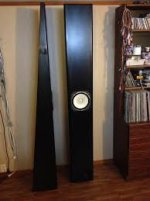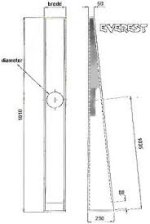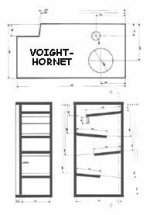A cordless mini router is more better.
Once I used a cordless, I never went back.
They're very easy to use, and 18V, 6A is plenty powerful.

Once I used a cordless, I never went back.
They're very easy to use, and 18V, 6A is plenty powerful.
Have a few questions on your experience with the hand-held router:
1. what material do you rout with this unit - MDF, fiberboard only or ply wood also?
2. What is the max router bit diameter you can use?
3. Have you tried bevel bits or round-over bits?
It is equally or more powerful than a wired router or trimmer (mini router) and can be used in the same way.
Of course, even hard solid oak or birch wood is no problem.
The bit axis is max 8mm on all three models.
I don't know the answer to your third question.
it’s now 140mm, but I Can easely shorten the wood.what is the minimum diameter you can fraze with this thing?
Last edited:
hi Brielle, thanks a lot for all the preliminary work! thanks to you I got enthusiastic to build the Sibelius myself! gr. WilI wish you all the best with your self built Sibelius. I am ready and very happy with them. Thanks for joining and your comments. Kind regards from The Netherlands, Brielle. ;-)
it is a Metabo FM 500-6. the adjustment of the diameter has to be done with screws, so a lot of manual work and measuring…nice router. what make is it?
how do you adjust the radius accurately, repeatably and
No Thx Wil, nice!hi Brielle, thanks a lot for all the preliminary work! thanks to you I got enthusiastic to build the Sibelius myself! gr. Wil
The steel plates 5mm are ready, cut at a local steel and laser company. The stainless steel spikes are from China…
Thnx to @Hondasnl 4 the precise drawing! Only changed to 8mm screw thread.


Thnx to @Hondasnl 4 the precise drawing! Only changed to 8mm screw thread.
A question about de folding direction of the Voigt tube.
Real World audio (youtube) has some opinions about folding the point of a Voigt pipe backwards, rather than forwards.
Explained in this video.
To me as a beginner it makes sense. Would anyone here be able to explain why most folded designs have the point on the front panel?
Real World audio (youtube) has some opinions about folding the point of a Voigt pipe backwards, rather than forwards.
Explained in this video.
To me as a beginner it makes sense. Would anyone here be able to explain why most folded designs have the point on the front panel?
A question about de folding direction of the Voigt tube.
Real World audio (youtube) has some opinions about folding the point of a Voigt pipe backwards, rather than forwards.
Explained in this video.
To me as a beginner it makes sense. Would anyone here be able to explain why most folded designs have the point on the front panel?
If the Voigt tube tip is folded backward, there will be a lot of leakage of mid and high frequencies through the aperture, so polyfill under the driver is necessary.
I prefer to fold the Voigt tube tip forward, making the opening duct-like and not using polyfill.
I think you should try it and choose your preferred method.
Generally you select the internal geometry based on the optimum driver tap (offset) location. At least, you 'should'. 😉 But probably 75% of folded ML Voigts are completely unnecessary anyway, since you'd get equivalent / better results with an MLTL, the extra gain BW of the expanding pipe not being needed / especially useful. With a few exceptions, I tend to see ML Voigts when unfolded as aesthetic choices, which vanishes as soon as you fold them up into a regular rectilinear box.
For why you see one particular configuration more than the others -I suspect the main reason has nothing to do with functionality in most cases, but simply that it was popularised earlier, at least in the West, by Weems & others, so it's what people are familiar with. Assuming the terminus area is < Sd there should be no midrange leakage from the driver per se due to the acoustic impedance mismatch, although if the driver is poorly located there may be issues with pipe harmonics, particularly F3 & F5.
For why you see one particular configuration more than the others -I suspect the main reason has nothing to do with functionality in most cases, but simply that it was popularised earlier, at least in the West, by Weems & others, so it's what people are familiar with. Assuming the terminus area is < Sd there should be no midrange leakage from the driver per se due to the acoustic impedance mismatch, although if the driver is poorly located there may be issues with pipe harmonics, particularly F3 & F5.
The Sibelius is made from 32mm solid oak or 32mm birch plywood, which prevents the compressed sound waves in the tip from passing through to the front of the speaker. and of course we want to make an exact copy of the Sibelius. the best speaker I've heard!A question about de folding direction of the Voigt tube.
Real World audio (youtube) has some opinions about folding the point of a Voigt pipe backwards, rather than forwards.
Explained in this video.
To me as a beginner it makes sense. Would anyone here be able to explain why most folded designs have the point on the front panel?
Last edited:
Wow, that is a small paradigm shift for me. Would you have a design that to your opinion is better with the Alpair 10.3 units than the Sibelius?Generally you select the internal geometry based on the optimum driver tap (offset) location. At least, you 'should'. 😉 But probably 75% of folded ML Voigts are completely unnecessary anyway, since you'd get equivalent / better results with an MLTL, the extra gain BW of the expanding pipe not being needed / especially useful. With a few exceptions, I tend to see ML Voigts when unfolded as aesthetic choices, which vanishes as soon as you fold them up into a regular rectilinear box.
For why you see one particular configuration more than the others -I suspect the main reason has nothing to do with functionality in most cases, but simply that it was popularised earlier, at least in the West, by Weems & others, so it's what people are familiar with. Assuming the terminus area is < Sd there should be no midrange leakage from the driver per se due to the acoustic impedance mismatch, although if the driver is poorly located there may be issues with pipe harmonics, particularly F3 & F5.
@Paulus NL
Do you have a pair of Alpair 10.3s? They can be tough to get these days.
Scott and Dave have at least two good designs for this driver particularly: the Pensil -- which presaged the form factor of the Sibelius -- and the Frugel Horn XL.
I'm leaning toward the FHXL but the Pensil -- especially with the optional internal bracing is very attractive.
I'm sure they have other designs to suggest.
Do you have a pair of Alpair 10.3s? They can be tough to get these days.
Scott and Dave have at least two good designs for this driver particularly: the Pensil -- which presaged the form factor of the Sibelius -- and the Frugel Horn XL.
I'm leaning toward the FHXL but the Pensil -- especially with the optional internal bracing is very attractive.
I'm sure they have other designs to suggest.
22 minute video, he started spewing crap within the second minute. So i couldn’t watch moire and i would not pay attention to anything he says.
A properly designed ML-Voigt has a Zd right at 50%. Aslong as you fold the basic “festival” style straight Voigt such that the driver fires in the dirction you need it to face.
Festival style:

The usual single folding. You can put the driver on any of the 4 sides bu will need to adjuat where the point starst to get the appropriate Zd
We sed this folding in Mileva, Demetri

Here a clever folding that rose from opposite sides of the planet… Scott (Yorkshire) for the FF108e∑ and FF165wk, and Nadape (Japan) for more than that.

And just to throw a fish intothe works, Zd is not always 50%.
And then there is the folded Metronome, a good start for an upfiring omni
dave
I remember in the 70th that I saw this voighthorn first time with Fostex drivers. They called them "Everest". Because of the highs.
I didn't build them myself but a friend did. I heard them and I thought they was poor of bass.
Now I understand why.
I didn't build them myself but a friend did. I heard them and I thought they was poor of bass.
Now I understand why.
Attachments
Last edited:
I confess, I didn't watch the videos. I rarely do -I just don't often have time to sit around watching them. So please forgive my above post if it seems a bit disconnected: it was written purely in the context of answering the question as-written rather than anything that might be on the youtube videos. I was going to cast an eye, but from what Dave says, probably best avoided. 😉
Yes, Everest was a famous one in the '90s & early 2000s, around the 'proper' dawn of the 'net. Assuming you picked a reasonable driver it could be acoustically efficient, but at the price of limited extension -especially since people tended to drop low Q Lowthers, Fostex units etc. into them, sometimes without compensation from the amplifier or relevant series R.
Yes, Everest was a famous one in the '90s & early 2000s, around the 'proper' dawn of the 'net. Assuming you picked a reasonable driver it could be acoustically efficient, but at the price of limited extension -especially since people tended to drop low Q Lowthers, Fostex units etc. into them, sometimes without compensation from the amplifier or relevant series R.
Last edited:
That's me in a slightly difficult position since a/ I know what's in Sibelius (under non-disclosure agreement), and b/ while I admire it, it's created under a different set of requirements to most DIY projects, with a different drive unit, by a different designer with slightly different priorities & approaches. Basically, it depends where your acoustic priorities lie, how large an enclosure you can handle, what aesthetics you favour etc. -as well as if you've got the drivers of course. 😉 There are quite a few good options for 10.3 / 10P & other MA drivers, so if you can narrow things down a bit, we might be able to make some suggestions -which obviously may include the homage to Sibelius here of course.Wow, that is a small paradigm shift for me. Would you have a design that to your opinion is better with the Alpair 10.3 units than the Sibelius?
- Home
- Loudspeakers
- Full Range
- Pearl Acoustic Sibelius


